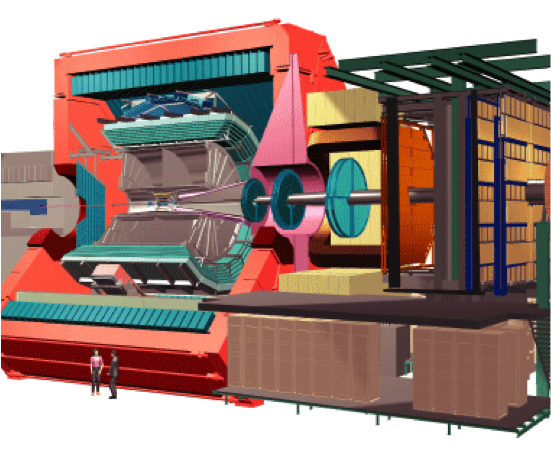Experimental research in high energy nuclear physics
Profs. William Llope, Claude Pruneu, Prof. Joern Putschke, Prof. Sergei Voloshin
Relativistic heavy ion physics involves the study of nucleus-nucleus collisions at high energy in order to study the behavior and properties of extended nuclear matter under extreme conditions of high density and temperature. Key facets of this research involve the study of the collision dynamics and the properties of the quark-gluon plasma phase produced in the midst of the collisions.
This field of research offers the only means to study the fundamental theory of strong interactions in the high-density limit and to observe directly the parameters of the predicted phase transition. It may also enable us to study the physical properties of the Quantum Chromodynamics vacuum state which reflects manifestly long-range phenomena over large distance scales, not realizable in collisions of elementary particles. Relativistic collisions of heavy ions provide information on the equation of state of nuclear matter at densities relevant to the interior of neutron stars and furthers our understanding of the beginning of the universe.
The Wayne State University experimental heavy ion group is supported by the U.S. Department of Energy and consists of four faculty, four research associates and post-docs, and several graduate students. Members of the group have been active collaborators in fixed target experiments E814, E877, E864, E896, E941 at the BNL AGS, as well as experiments NA45 and NA49 at the CERN SPS. A total of 47-refereed publications were produced by the above experiments. Of these, 30 were lead by members of our group. Nine Wayne State students received a degree based on their participation to these experiments.

During the last decade, members of the group have focused their activities on the development, deployment, and operation of the STAR Experiment at the Relativistic Heavy Ion Collider, and on the analysis of the large body of data it produces. Members of the group have played critical roles in the development and deployment of the STAR experiment. This includes project management responsibility for the Silicon Vertex Tracker, SVT (Professor Bellwied), the Electromagnetic Calorimeter, EMC (Professor Cormier), the online, and the integrated tracker (ITTF) projects (Professor Pruneau). The STAR Collaboration has published in excess of 750 peer reviewed papers published as letters, articles, or conference proceedings. Student members of STAR have produced in excess of 209 MS and PhD theses.
Many of these papers involved members of the Wayne State group as primary authors, thereby making the group a strong leader of RHIC physics as well as its associated technologies. The group physics interests and analysis activities cut across many areas relative to the discovery and characterization of the quark-gluon plasma (QGP). In essence, the group has contributed to virtually all aspects the RHIC heavy ion program. Specific topics include the discovery (Professor Voloshin, first STAR paper) and study of flow at RHIC; the study of event-by-event fluctuations of transverse momentum, net charge, and chemical abundances; measurements of two-particle short (HBT) and long-range correlations; measurements of strangeness production, equilibration, and flow; study of high pt particle production, and azimuthal correlations; and finally hard-probe studies with the EMC. Eight Wayne State students have completed their degree based on their research with the STAR experiment.

The Wayne State RHIC group also has an active participation to the ALICE Collaboration and is conducting a vigorous research program at the CERN Large Hadron Collider (LHC) with studies of light- and heavy-ion ultra-relativistic collisions. In ALICE, the group has lead the construction and deployment of the ALICE EMCal, a large electromagnetic calorimeter, specifically tailored for the study of jets, electron, and photon productional the LHC. Most recently, under the leadership of Prof. W. Llope, the group has also participated to the construction and deployment of GEM detectors included in the new readout system of the ALICE Time Projection Chamber (TPC). The ALICE Collaboration began taking data at the LHC in 2010. It has now accumulated a very large body of measurements in Pb-Pb, Xe-Xe, p-Pb, and pp collisions. Overall, ALICE has so far published in excess of 807 papers, of which 554 are articles published in peer review journals. Student members of the collaboration have completed 400 MS and PhD theses. Five Wayne State students have completed their degree based on works done with the ALICE Collaboration.
The RHIC group provides a dynamic learning environment for post-doc researchers, graduate and undergraduate students. The group typically hosts 4-5 postdoctoral researchers and at least half a dozen graduate students working either on an MS or PhD program. Several of the group's alumni are now faculty at other academic institutions or have joined research groups at national laboratories here in the USA or abroad.